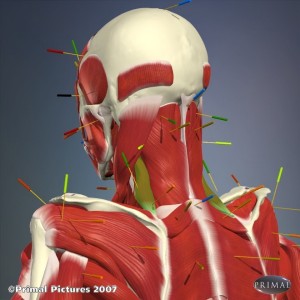 Audience: Therapists and Patients interested in knowing one theory of how neuroanatomical acupuncture (dryneedling) works.
Audience: Therapists and Patients interested in knowing one theory of how neuroanatomical acupuncture (dryneedling) works.
A caveat: Everything in this post id debatable. I think that considering the prevalence of acupuncture’s usage it is not well validated and many basic studies need to be done. That being said I think the post below summarizes one theory of acupuncture. Do with that what you may.
Source of Information: The following article is completely stolen with permission from a friend, Dr. Andreo Spina at http://functionalanatomyblog.com/. Dr Spina is a chiropractor and sports injury specialist. For therapists looking for continuing education and looking to expand their anatomy, palpation and soft tissue treatment skills Dr Spina’s courses are and excellent introduction or great alternative to other courses you may have taken in the past. I have worked with a lot of his instructors (some were students of mine but I learned more from them) in the past and they are dedicated to scientific rigor.
Below is a case study the explains an neuroanatomical acupuncture approach to managing a common condition. From my training, this approach is rooted in the McMaster Contemporary Acupuncture (see website here) approach taught by a great Sports Med Doc (Dr. Alejandro Elorriaga Claraco). This is my approach to acupuncture and the following article is very good explanation of what I attempt to do.
Control of Pain from a Tibial Stress Fracture using Medical Acupuncture: A Case Report
By: Dr. Andreo A. Spina
Introduction
Although it has been utilized as a therapeutic modality for upwards of 3000 years, only since the 1970s has acupuncture (dry needling) gained a greater scientific understanding as to the mechanisms underlying its analgesic effects.1,2 This growth in understanding of acupuncture analgesia (AA) has occurred in conjunction with the scientific advances made in uncovering the physiology of pain perception. As interest regarding the use of acupuncture in conjunction with other manual medical techniques grows, it is fortunate that a substantial body of evidence to support its efficacy exists.2 Although acupuncture treatment has with held the test of time, the modern health care system is continually demanding more evidence based practice. Therefore, it is important that this modality holds up to the scrutiny of the medical community in order to thrive as an accepted medical therapy.
The usefulness of electroacupuncture (EA) and manual acupuncture on pain relief has been well established.3 With well over 100 papers from the western scientific literature; a strong basis for its mechanism has been developed.4 AA is initiated by the stimulation of small diameter nerves in muscles that send impulses to the spinal cord. Then, three neural centres (spinal cord, midbrain, and hypothalamic-pituitary axis) are activated to release transmitter chemical (endorphins and monoamines) which block “pain” messages.4 In association with these mechanisms, literature looking at c-Fos gene expression sheds light on the long lasting analgesic effects of dry needling through neuromodulation.5
Outlined is a case of an elite competitive dancer who developed a stress fracture of her tibia as a result of a dramatic increase in her training schedule. As the athlete decided that she did not want to cease competition at that time, her pain symptoms were managed using medical acupuncture.
Case
A 17-year-old competitive dancer presented with a complaint of anterior leg pain which began 2 days prior to her presentation. The patient attributed the pain to a dramatic increase in her training schedule in preparation for competition. Her normal frequency of training was 3-4 times per week for approximately 4 hour sessions. Training was increased to 10 hours per day for a full 8 days prior to her presentation. The pain was described as a “severe ache” in the middle to lower 1/3 of her left leg. The pain developed throughout the training day and did not subside. By the end of the week, the patient was unable to complete her training due to what she described as “excruciating pain” rated as an eight to nine out of ten in intensity. By this time, she had also been experiencing night pain, as well as pain at rest that increased with prolonged standing or walking. When questioned concerning her menstrual cycle and diet, she claimed that her cycle was regular, and that she eats a very balanced diet including calcium and vitamin D supplementation.
Observation revealed bilateral genu valgus accompanied by bilateral subtalar over pronation. No visible edema or discoloration was seen in the area of the chief complaint. Range of motion of the ankle produced pain on the medial aspect of the tibia with passive dorsiflexion of the left ankle. All other ankle and knee ranges were full and pain free. Palpatory findings revealed maximal tenderness and a reproduction of pain with osseous palpation of the tibia at a point between the middle to lower 1/3. Pain was also elicited with palpation of the flexor digitorum profundus, as well as the medial edge of the soleus. Bowing of the tibia (Fulcrum Test) was performed by placing the left forearm under the gastrocnemius muscle proximal to the area of chief complaint as the patient lay supine on the table. The patients ankle was then grasped using the right hand while applying an anterior to posterior force perpendicular to the long axis of the tibia towards the table. This maneuver also reproduced the patient’s complaint. Therapeutic ultrasound was applied over the tibia. This caused pain when the ultrasound head traversed the area of chief complaint.
The preliminary diagnosis for the patient was a tibial stress fracture. At this time she was referred for films that came back unremarkable. Following this, the patient was scheduled for a bone scan. The bone scan revealed focal increased uptake in the left middle to lower 1/3 of the tibia shaft consistent with a tibial stress fracture.
Due to the nature of the injury, the athlete was advised by both the author, as well as a sport medical doctor to cease all training and begin a course of relative rest and decreased weight bearing. The patient refused to comply with the recommended course of therapy and felt that she wanted to continue training at a
decreased frequency until the end of her competition in one month’s time. After explaining the potential consequences of this action, medication was offered for pain control which was not accepted by the patient. As such, medical acupuncture was substituted as a method of pain modulation.
The patient was treated with a frequency of 3-4 times per week. Treatment sessions were 30-45 minutes in duration and consisted solely of electro acupuncture application. While in the supine position, needles were placed into the medial side of the leg, immediately posterior to the tibia extending in a line spanning the painful site. As well, needles were also placed in the area of the points traditionally referred to as spleen 6 and nine (SP6, SP9), as well as kidney 3 (KI3). In the medical acupuncture model, these points were selected in order to modulate the afferent information along the tibial nerve. Traditional points liver 3 (LV3), gallbladder 34 (GB34), and stomach 36 (ST36), were also selected bilaterally in order to enhance suprasegmental mechanisms of pain relief (see discussion below). The patient was then placed in a prone position where needles were placed in the paraspinal musculature of the L4-5, as well as the sacral foramina of the S1-S3 levels. This was performed in order to activate the segmental mechanisms of analgesia (see discussion below) pertaining to the tibial nerve. During the course of the treatment high intensity, low frequency (2-4 Hz) electrical stimulation was applied to the needles.
The patient reported that the level of pain during training had reduced from 8-9/10 as it presented, to approximately 4/10 after two treatment visits. At this level of pain, the athlete was able to continue her training regimen and successfully compete with what she felt was an “acceptable level of discomfort.”
Discussion
Pain is an unpleasant sensory and emotional experience associated with actual or potential tissue damage.6 The current thinking underlying pain perception and inhibition accepts a dynamic, malleable, and complex set of interacting neurons, with gene regulation and expression producing a variety of neuropeptides and cytokines at the peripheral nervous system (PNS) and central nervous system (CNS) level.2 Although pain is mediated by the nervous system, a distinction must be made between pain and the neural mechanisms of nociception—the response to perceived or actual tissue damage.6 Nociception, a complex series of electrochemical events that occurs between a site of active tissue damage and the perception of pain, is one factor in the pain experience.7 Although other factors contribute to the experience of pain, understanding nociception, and the influence that certain manual modalities can have on it, is important in the clinical management of pain (as a description of pain physiology is out of the scope of this report, the reader is referred to Lynch, Kessler, and Hertling’s text).8
The mechanism of acupuncture induced analgesia can be summarized as affecting the nociceptive transmission system at three areas: locally, at the level of the spinal cord and midbrain level, and in “suprasegmental areas” including the hypothalamic-pituitary system (HPS).2, 4, 9, 10
The Contemporary Medical Acupuncture approach utilizes dry needling in areas of the body (termed “inputs) attempting to affect each of these levels. Thus there are local inputs, which includes needles placed into the tissues producing the pain signal; there are spinal inputs, where needles are placed in the paraspinal musculature at levels corresponding to the neural innervation of the pain producing tissue; and finally there are suprasegmental inputs, where needles are inserted into powerful “neuro-reactive” sites that are known to influence pain-modulation at higher levels of the central nervous system.
Local needling can affect changes in muscle and local tissue such that a vasodilatory effect is produced causing a reduction in the accumulation of pain producing substances that can be found in tight and spastic muscles.10 The acupuncture needling of a muscle stimulates the nerve endings of calcitonin gene-related peptide (CGRP) neurons. This substance is known to have a vasodilator action.11 The nerve impulses from these nerve endings propagate to the collateral nerve branches innervating the endings of the cholinergic vasodilator nerve fibers within the sympathetic nerve, which dilates the blood vessels in the muscle thus improving circulation.10
In conjunction with local vasodilatory effects, pain modulating mechanisms also occur via afferent inputs from the area of needle placement. Needling into tissue activates sensory receptors that send impulses to the spinal cord along type II and III afferents (in the case of muscular insertion, and along A-delta fibers from the cutaneous puncture).4 Within the dorsal horn of the spinal cord, these fibers send a collateral branch to synapse on an endorphinergic cell. This cell releases either enkephalin or dynorphin causing a pre-synaptic inhibition (“gating the pain”) of the pain signal from the irritated small afferent fibers of the injured tissue (C-fibers) as they synapse onto lamina II and III of the dorsal horn.4 The pre-synaptic inhibition probably works
by reducing calcium current inflow during the action potential in the nerve terminals, resulting in a reduced release of the pain transmitter.4
Arising from both needling the local painful tissue, as well as by needling the paraspinal musculature corresponding to the neural innervation of that tissue, the afferent signal from the type II and III afferents continue up the spinal cord along the contralateral antero-lateral tract (ALT).9 The signal transmitted along the ALT projects to the midbrain causing excitation of the periaqueductal gray matter (PAG) in the mesencephalon.2, 4, 8, 9 PAG excitation causes a release of enkephalin which subsequently leads to activation of the nucleus raphe descending system (including the Nucleus raphe magnus or reticularis magnocellularis and locus ceruleus) located in the medulla.2, 4, 8 The efferent pain modulating signal from these nuclei descend the spinal cord along the dorsolateral funiculus and arrive at the dorsal horn.2, 4, 8 Here there is a release of monoamines serotonin (5HT) and norepinephrine. Increases in serotonergic neurotransmission has been associated with decreased pain sensitivity and/or reactivity, while increased norepinepherine content in the spinal cord of rabbits and rats was universally reported to facilitate acupuncture analgesia.12, 13 As well, 5HT fibers have also been found running from the midline raphe nuclei in the midbrain and ventromedial reticular formation through the ventral tegmentum and medial forebrain bundle to innervate forebrain structures including the amygdala, neocortex, and hippocampus.9
Perhaps the least understood of the three levels contributing to acupuncture analgesia is that of the contribution of the hypothalamic complex. As afferent signals from the site of needle input ascend the spinal cord to the various segments discussed earlier, they also rise to the level of the arcuate nucleus located in the hypothalamus causing an endogenous opioid mediated affect of acupuncture.4 Perhaps the most exciting experiments which opened up the field of AA to scientific research were those in which endorphin antagonists (e.g., naloxone) were used. Naloxone is a known inhibitor of morphine produced analgesia. The blockage of AA by naloxone in various studies suggest a role for endogenous opioids the mechanism.9 As an example, studying acute laboratory-induced tooth pain in human volunteers, Mayer et al. produced AA by manual twirling of needles in the acupuncture point LI 4 (Large Intestine 4) located in the first dorsal interosseous muscle of the hand. Utilizing a double blind design, they administered IV naloxone to one group, while the other received saline. The saline group achieved AA, however the naloxone group, AA was not achieved.14 In the medical acupuncture model, certain strong “systemic” points are used to elicit this “suprasegmental” effect. Some of which include the traditional points LI4, LV3, SI3, BL60, and KI3 which are located on distal areas of the extremities.
Continuing the neurological path from above, activation of the arcuate nucleus of the hypothalamus leads to a subsequent activation of the pituitary gland, which releases beta-endorphin into the blood and CSF.15 Some evidence suggests that the pituitary-portal venous system can carry this hormone in a retrograde direction directly to the brain inducing analgesia.4 Beta-endorphin can also contribute via two other mechanisms. First, the presence of beta-endorphin in the CSF acts to stimulate the raphe nucleus thus executing the descending pain inhibitory path. Second, there is an important correlate of pituitary beta-endorphin release. That is that adrenocorticotrophic hormone (ACTH) and beta-endorphin are co-released into circulation on an equimolar basis (They stem from a common precursor).4 It is well known that ACTH travels to the adrenal cortex causing the release of cortisol into the blood. Cortisol has well known anti-inflammatory properties which may explain why acupuncture is helpful in blocking the inflammation of arthritis and the bronchospasms of asthma.4
As in the case presented above, medical acupuncture often utilizes electrical input through the acupuncture needles in order to stimulate different neurological responses. In classical acupuncture, needle stimulation is achieved by slow or rapid, mild or strong manipulations of the needle. Today, the majority of studies have been performed using the electrical stimulation method. Numerous studies have shown that the mechanism of analgesia production differs with altering the frequency and intensity of the electrical input.2, 4, 9 Low intensity and high frequency (50-200Hz) electrical stimulation has a faster onset of action but does not have as prolonged effect as high intensity and low frequency (2-4 Hz) input. The former is thought to involve only local and midbrain effects, whereas the latter also involves “suprasegmental” influences from the hypothalamic-pituitary axis as discussed above.16 An additional difference is that low intensity, high frequency stimulation creates a more rapid onset analgesia but of very short duration, while high intensity, low frequency produces a more slow onset, however longer lasting effect outlasting the 20-minute stimulation session by 30 minutes to many hours.4 The low frequency stimulation also produces a cumulative effect, showing increased improvement over several treatments.4
Conclusion
Manual medicine practitioners who treat with high level athletes are often faced with the challenge of dealing with those who refuse to refrain from training or competition. These patients often rely on their treating doctor, or therapist to manage their condition to the point that they are still capable of competing with the least amount of pain and dysfunction possible. In the case outlined above, the athlete required that the pain produced by her tibial stress fracture be held at a manageable level until the end of her competition season.
The usefulness of electroacupuncture (EA) and manual acupuncture on pain relief has been well established with well over 100 publications in the western scientific literature creating a strong basis for its mechanism.3, 4 The mechanism of acupuncture induced analgesia can be summarized as affecting the nociceptive transmission system at three areas: locally, at the level of the spinal cord and midbrain, and in “suprasegmental areas” including the hypothalamic-pituitary system (HPS).2, 4, 9, 10 Activation of these three systems can differ depending on the selection of electrical stimulation be it low intensity, high frequency to produce fast acting, short duration analgesia, or high intensity, low frequency stimulation to additionally utilize the suprasegmental effects producing a longer lasting, cumulative analgesic effect.
In the outlined case, medical acupuncture was successfully utilized to significantly reduce the athletes pain levels enough to allow her to continue to train and compete. It should be noted that the original advice of both the athletes medical doctor, as well as the author, was to refrain from weight activity altogether however the determination of the athlete to keep competing determined the outlined plan of management.
As more evidence on various manual therapeutic interventions become available, it can be assumed that practitioners utilizing evidence-based medicine will seek training in various disciplines in order to enhance their treatment outcomes. Acupuncture is a well-established treatment modality with over 2000 years of history. However, as with all other treatment modalities, it is important that continuing research be done on the topic in order for it to thrive in these times which are placing increasing importance on evidence based practice.
References:
1. Diehl DL, Kaplan G, Coulter I, Glik D, Hurwitz E. Use of Acupuncture by American Physicians. The Journal of Alternative and Complementary Medicine 1997;3(2):119-126.
2. Audette JF, Ryan AH. The role of acupuncture in pain management. Phys Med Rehabil Clin N Am 2004;15:749-772.
3. Ishimaru K, Kawakita K, Sakita M. Analgesic effects induced by TENS and electroacupuncture with different types of stimulating electrodes on deep tissues in human subjects. Pain 1995;63:181-187.
4. Pomeranz B. Acupuncture Analgesia – Basic Research. In: Basics of Acupuncture. 4th ed. New York: Springer-Verlag; 1998. p. 1-27.
5. Morgan JI, Curran T. Stimulus-transcription coupling in the nervous system: involvement of the inducible proto-oncogenes fos and jun. Annu Rev Neurosci 1991;14:421-51.
6. Kandel ER, Schwartz JH, Jessel TM. The Perception of Pain. In: Principles of Neuro Science. 4th ed. New York: McGraw Hill; 2000. p. 472-491.
7. Fargas-Babjak A. Acupuncture, Transcutaneous Electrical Nerve Stimulation, andn Laser Therapy in Chronic Pain. The Clinical Journal of Pain 2001;17:S105-S113.
8. Lynch MK, Kessler RM, Hertling D. Pain – Chapter 4. In: Musculoskeletal Disorders: Physical Therapy Principles and Methods. 3rd ed. Philadelphia: Lippincott-Raven Publishers; 1996. p. 50-66.
9. Kho H, Robertson EN. The Mechanisms of Acupuncture Analgesia: Review and Update. American Journal of Acupuncture 1997; 25(4): 261-281.
10. Takeshige C. Mechanism of Relief of Muscle Pain by Needle Insertion into Acupuncture Points. “Acupuncture” The Scientific International Journal 1990;1:7-12.
11. Brian SD, Williams TJ, Tippins JR, Morris HR, Macintyre I. Calcitonin Gene-Related Peptide is a Potent Vasodilator. Nature 1985;313:54-56.
12. Roizen MF, Newfield P, Eger II EI, Hosobuchi Y, Adams JE, Lamb S. Reduced anesthetic requirement after electrical stimulation of periaqueductal grey matter. Anesthesiology 1985;62:120-123.
13. Han JS, Guan XM, Xu JM. Study of central norepinephrine turnhover during acupuncture analgesia in rat. Acta Physiol Sin 1979:31:11-19.
14. Mayer DJ, Price DD, Raffii A. Antagonism of acupuncture analgesia in man by the narcotic antagonist naloxone. Brain Res 1977;121:368-372.
15. Sjolund B, Terenius L, Eriksson M. Increased cerebrospinal fluid levels of endorphins after electroacupuncture. Acta Physiol Scand 1977;100:382-384.
16. Debreceni L. Chemical releases associated with acupuncture and electric stimulation. Crit Rev Phys Rehab Med 1993;5:247-75.
Thanks for reading,
Greg Lehman
A source for Toronto Physiotherapy



